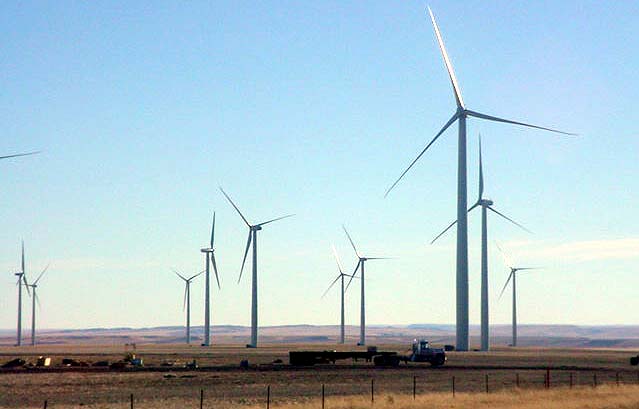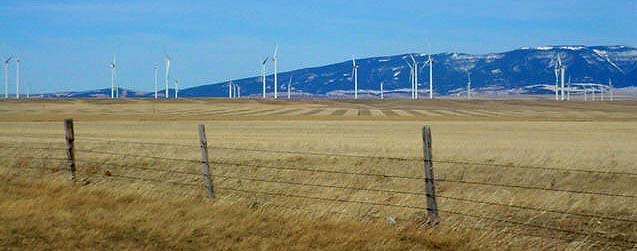Wind Generators near Judith Gap
Photo Courtesy of
Geoff Smith, Science Teacher at Judith Gap

January of 2006 marked the completion of Montana's first major
wind power project. Located between Judith Gap and Harlowton
(between Billings and Great Falls), the project includes 90 wind-
powered generators, each capable of producing enough
electricity for 300 to 400 homes. The generators are owned by
a Chicago based company called Invenergy, which sells the
electricity to Northwestern Energy. Each generator stands about
260 feet tall in order to tap the stronger winds found farther
from the surface.
Why here? . . .
According to an Invenergy spokesman the winds in January of
2006 averaged 42.6 miles per hour. But these strong, steady
winds weren't the only factor that made this site appealing. The
site is also close to a major transmission line that runs between
Great Falls and Billings; two population centers that represent a
significant demand for power.
How to make electricity . . .
A wind-powered generator works like a fan in reverse. Instead of
using electricity to move air like fans do, wind generators use
mving air (wind) to generate electricity. Here's how it works. . . .
To make (generate) electricity, you need three things: a magnet,
a wire, and motion. If you take a magnet and move it in close
proximity to a wire, this causes an electrical current to flow
within the wire. Within a generator, wires and magnets are
organized so that a current will be produced in the wires if
motion is provided. Generators can be designed to utilize all
sorts of motion ranging from the peddling motion of a bicycle to
the motion of water through the bottom of a dam. At coal-fired
plants, coal is burned to heat water. As the water changes to
steam it shoots through a turbine, providing the motion. With
wind generators, the wind turns propeller-shaped turbines to
generate electricity.
CLICK HERE to watch a short wind generator demonstration (less than 2 minutes).
Pros and cons . . .
Over half of the electricity used in Montana
comes from coal-fired generators, primarily those located at Colstrip in the southeastern part of the state. Dams are
the other primary source. A big advantage of wind-generated power (and hydro-power) is that there are no emissions. Coal-fired plants emit carbon dioxide (a major greenhouse gas) as well as sulfur dioxide and mercury. One problem associated with wind generators is that power companies, such as Northwestern, have to buy power from other sources to keep the power flowing when the wind isn't blowing. The short-term nature of these additional sources of electricity cause them to be more expensive.
Windfall for county . . .
Another plus for the area is the revenue (income) that the
project will provide for Wheatland County. The county expects
to get over $750,000 in "impact money" over the next three
years to offset the impact of construction. Projects such as this
have an "impact" on schools, roads, water and water systems,
fire departments, etc. Impact dollars help counties pay for these
services. Also, the wind generators will continue to generate tax
dollars for the county and state for years to come.
 Photo By Geoff
Smith
Term: barotrauma (*see hot link below)
| 





